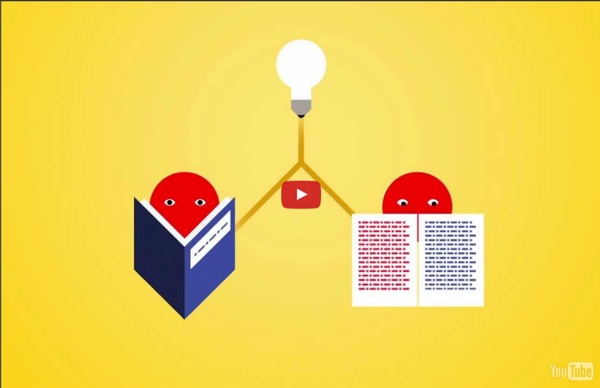



http://www.youtube.com/watch?v=WyzJ2Qq9Abs
Related: VideosCairns Blog: Crowdsourcing Governance [Video intro ends at 52 seconds; Intro by Dr. Gref ends at 2'18; Speech ends at 11'15; then Q&A] For Prime Minister Putin's presentation, click here. Take aim at innovation, with students in the center In September 2012, I packed up my Prius, left my patient wife, and drove around the United States for 89 days and 10,000 miles visiting 64 schools of every flavor and size to find out how they are preparing students for a rapidly changing world. I asked questions and recorded learning with more than 600 teachers, administrators and students. In setting up the complex matrix of this trip, many of my hosts asked, “What would you like to see when you are here?” The journeys of discovery in my life have started with open goals and few preconceptions, so I left the agendas as open ended as possible, with one caveat: I was not interested in seeing a 1:1 laptop program or talking with teachers about their tablet rollouts. As others have said, technology in learning should be as ubiquitous as air, and there is nothing innovative about students and teachers breathing.
Crowdsourcing improves predictive texting - tech - 25 February 2012 SMARTPHONES may soon get a lot better at finishing your sentences for you - with the help of words and phrases gleaned from crowdsourcing. The software packages in today's phones often struggle with texts and voice commands if a user attempts words or phrases that aren't included in the phone's database. To see if the crowd could help, Keith Vertanen of Montana Tech in Butte and Per Ola Kristensson at the University of St Andrews, UK, called upon workers of the Amazon Mechanical Turk. The plan was to try and improve a predictive system used in Augmented and Alternative Communication (AAC) devices, which help disabled people to communicate by painstakingly typing out words interpreted from their muscle twitches or blinks. The researchers paid 298 Mechanical Turk workers to imagine phrases they might need if they had motor neuron disease or cerebral palsy.
Reinventing School From the Ground Up For Inquiry Learning By Thom Markham A grave miscalculation exists in the minds of many educators: That inquiry-based learning, project based learning, and 21st century competencies can flourish in industrial model schools. Under this world view, the inquiry goals of the Common Core State Standards are “strategies” to be added to the existing list of classroom techniques, while skills like collaboration, communication, or creativity can be taught despite 43-minute periods, desks in rows, and pacing guides set in stone. In other words, reaching the top of Bloom’s Taxonomy is important, but less so than maintaining regimental order. But what we know—from industry and neuroscience—is that organizational structure, environment, and human performance are deeply intertwined. It is inevitable that schools must be completely redesigned if society wants to tap the wellsprings of creativity and exploration that the industrial system subdues.
Solver Develops Solution to Help Clean Up Remaining Oil From the 1989 Exxon Valdez Disaster Boston, MA and Cordova, AK - November 7, 2007 - InnoCentive, the leader in prize-based Open Innovation sourcing, is helping to make a positive impact on Environmental Conservation by working with the Oil Spill Recovery Institute (OSRI) and other conservation groups. OSRI has posted 3 Challenges on the InnoCentive website, all dealing with oil spill recovery issues. The first of these challenges was solved last week by an oil industry outsider who used his expertise in the concrete industry to come up with the winning solution. John Davis, an InnoCentive Solver from the Central United States, was awarded $20,000 for his creative solution. 6 Tips for Getting Started with Genius Hour Posted 05/22/2014 2:36PM | Last Commented 02/02/2015 11:36AM Genius hour is a great way to allow students to drive their own personalized instruction but where to begin such a big project? How to Get Started There are a lot of resources out there already, and most of the teachers that are embarking on this process are willing to share what they have or help you problem solve. The following all have something to offer:
See inside Buckingham Palace as Google and YouTube take the public on a 3D tour Visitors can stand at the bottom of the grand staircase and, although not able to move, have an almost 360-degree view of the architectural wonder. They can also look down the picture gallery at the Old Masters such as Canaletto hanging on the walls, then turn around to see paintings behind them. Other highlights include tours of the lavishly decorated Green and White drawing rooms and the ballroom - where knighthoods and OBEs are presented by the Queen during investitures - all accompanied by a virtual tour guide. It follows similar "indoor Streetview" projects which have taken visitors inside the British Museum, Royal Shakespeare Company and galleries around the UK. Google is behind the project and it has created a similar experience for schools under its Expedition pioneer programme, but instead of having a virtual guide, teachers dictate the tour and highlight interesting topics for pupils.
Microwork Microwork is a series of small tasks which together comprise a large unified project, and are completed by many people over the Internet. [1] [2] Microwork is considered the smallest unit of work in a virtual assembly line. [3] It is most often used to describe tasks for which no efficient algorithm has been devised, and require human intelligence to complete reliably. The term was developed in 2008 by Leila Chirayath Janah of Samasource. [4] [5] Microtasking[edit] Microtasking is the process of splitting a job into its component microwork and distributing this work over the Internet.